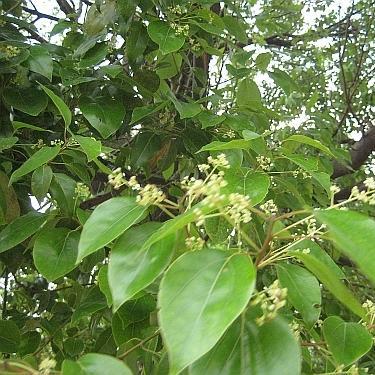
The price of camphor was once higher than the price of gold...
White camphor has a sharp, pungent camphoraceous odor.
Nature: clearing, stimulating
The vapors open the sinus and breathing passages to ease bronchitis and coughs.
Ideal for use as an insect repellant (flies, moths, etc.) in clothes and linen closets.
Principal Actions: Strong adrenal and cardiac stimulant; uplifting for languid depression.
Practical Uses
Methods of Use: local application (with caution), cold compress, inhalation (with caution), vaporize
Note: Camphor is not widely used in aromatherapy, as the oil is powerful and classed as a convulsant and neurotoxin.
Caution: White camphor is an adrenal stimulant and should be completely avoided by people prone to asthma or epileptic seizures. Avoid during pregnancy. Overdosing can cause convulsions and vomiting. Do not use on children. If used on adults, use very small amounts.
Raises low blood pressure, stimulates respiration, can be an aphrodisiac OR lessen strong sex drives.
Skin Care with White Camphor
White camphor has strong anti-septic and antiviral properties that are helpful (in small amounts) in the treatment of acne, inflammation, oily skin conditions, spots, skin ulcers or any long healing wounds.
For infected skin or long healing wounds: Use a cold compress with 4 drops frankincense, 4 drops myrrh and 2 drops white camphor.
Circulation, Muscles & Joints
White camphor is a strong heart stimulant, therefore can be given in cases of heart failure due to: extreme shock, cardiac disease. The anti-inflammatory and diuretic actions are useful in a cold compress for gout, arthritis, rheumatism and sprains.
Respiratory System
White camphor is a respiratory system stimulant. The vapors open the sinus and breathing passages to ease bronchitis and coughs.
Immune System
White camphor is used in conditions of infectious fevers such as typhoid and pneumonia.
Nervous System
White camphor is used in situations where there is languid depression; it has a sedative effect in cases of hysteria, shock and most psychosomatic or nervous diseases. Camphor will often produce results where milder remedies prove insufficient or when a gentle shock is required in order to produce some reaction from a chronically ill patient.
White Camphor in Aromatherapy:
Botanical Name: Cinnamomum camphora
Note: Base
Parts Used: from the wood of mature evergreen trees over 50 years old, 100 ft high and 10 ft in diameter
Source: extracted from the wood of trees grown in Japan
Description and Odour Effect: brown and yellow camphor is extremely poisonous. White camphor is a colourless to pale yellow liquid with a sharp, pungent odour. Only small amounts of the white camphor should be used due to its toxicity levels. Homeopathic remedies are negated by the vapours alone.
Blends well with: eucalyptus, frankincense, patchouli, spicy and herbal oils
Applications: local application (with caution), cold compress, inhalation (with caution), vaporize
Therapeutic Properties: analgesic, antibacterial, antidepressant, anti-inflammatory, antiseptic, antispasmodic, antiviral, cardiac, diuretic, expectorant, febrifuge, hypertensive, insecticide, stimulant (central nervous system; adrenal glands; respiratory system) vasoconstrictor, rubefacient, vermifuge
Safety Data: It is an adrenal stimulant and should be completely avoided by people prone to asthma or epileptic seizures. Avoid during pregnancy. Overdosing can cause convulsions and vomiting. Do not use on children. If used on adults, use very small amounts.
Note: Camphor is not widely used in aromatherapy, as the oil is powerful and classed as a convulsant and neurotoxin.
Chemical composition includes: a-pinene, camphene, b-pinene, sabinene, phellandrene, limonene, 1,8-cineole, y-terpinene, p-cymene, terpinolene, furfural, camphor, linalool, bornyl acetate, terpinen-4-ol, caryophyllene, borneol, piperitone, geraniol, safrole, cinnamaldehyde, methyl cinnamate and eugenol.
The brown and yellow camphor oil has a very high safrole content, with yellow having between 10 - 20 % and the brown having 80%. These two oils are considered toxic, as well as carcinogenic.
Source: Crude camphor is extracted by steam distillation from the wood of the semi-evergreen tree grown in China. Crude camphor is then rectified under vacuum and filter-pressed to produce three fractions: white, brown and yellow. White camphor does not contain safrol and is the only type used in aromatherapy.
Camphor is related to the cinnamon and cassia trees.
White Camphor – Quick Reference
Skin Care: acne, inflammation, oily conditions, spots, insect prevention (flies, moths)
Circulation, Muscles & Joints: arthritis, muscular aches and pains, rheumatism, sprains
Respiratory: bronchitis, chills, coughs
Immune: colds, fever, influenza, infectious disease
Nervous: languid depression, sedates hysteria and shock
Keyword: Clarity
The balancing and calming properties of camphor help nervous tension and worried minds; clearing as an inhalant; massage for sore muscles and joints.
Camphor Magic: sniff to lessen sexual desire. Also place beside the bed for this purpose.
If you appreciate the information provided,
please help keep this website running. Blessings!
© 2008-2025 aromaworx.ca. All rights reserved.

